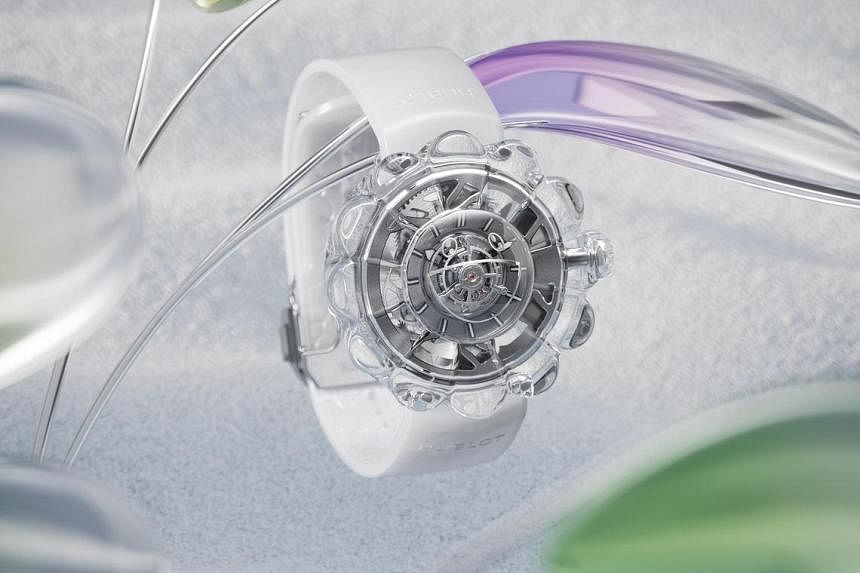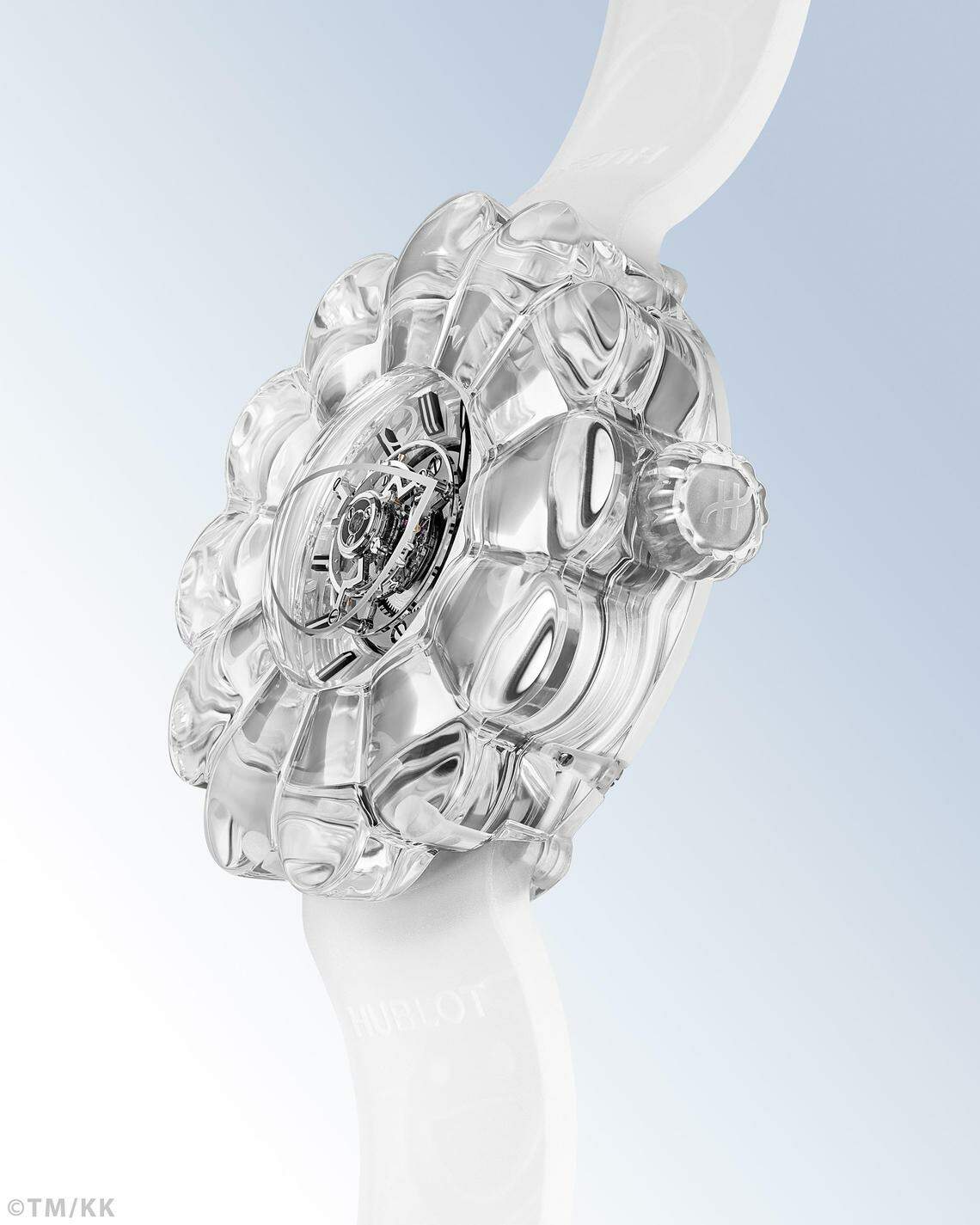SINGAPORE – Japanese artist Takashi Murakami harbours mixed feelings about the pandemic years. Although tough, they were, he lets on, “super creative” for him.
Closed borders made travel impossible, so the 61-year-old – who pioneered “superflat”, a postmodern art movement influenced by manga and anime – would stay all day in his studio, pondering issues and thinking about new ideas from “morning to midnight”. These included non-fungible tokens (NFTs), the metaverse and cryptocurrency.
Even though he was still creating, his head, he says, “was almost ash, there was nothing”.
But the Covid-19 years jump-started his creative engine again, not just reigniting but also sharpening the storytelling in his art.
His latest creation, an ethereally beautiful timepiece which he unveiled in Singapore in November, bears testimony to this. A collaboration with Hublot, the MP-15 Tourbillon Sapphire magnificently combines one of his favourite motifs – the flower – with the Swiss watchmaker’s horological prowess.
Limited to just 50 pieces, the $466,300 watch boasts a transparent all-sapphire case with 12 petals and houses a central tourbillon, a horological first for Hublot. Also crafted from the same material are the flange, caseback and crown.
Completing this transparent vision is the see-through rubber strap, which has a sapphire crystal and titanium deployant-style buckle.
It is not Murakami’s first watch for Hublot. In 2021, they introduced their first collaboration: his signature smiling flower stunningly interpreted in one of the brand’s most famous models, the Classic Fusion.
In the dramatically black piece, the flower’s 12 petals – encrusted with 456 black diamonds – sit on a Hublot-engineered ball-bearing system, which allows them to turn and move. The flower’s smiling face – encrusted with another 107 diamonds – is inserted into the sapphire glass, giving it a three-dimensional effect.
There have been a couple of other collaborations since, including 13 Hublot x Murakami Classic Fusion black ceramic watches sold with unique NFTs in February.
Holding court at Raffles Hotel in a room filled with international watch journalists, Murakami says he is extremely chuffed with the MP-15 Tourbillon Sapphire.
“It is a dream come true,” says the artist, who also founded a gallery and art production company Kaikai Kiki, which has studios in Tokyo and New York, and employs more than 200 assistants.
Famous for blending traditional Japanese art aesthetics with popular culture, Murakami’s paintings and sculptures fetch astronomical prices on the art market. At a Phillips auction in 2021, one of his artworks Red Demon And Blue Demon With 48 Arhats was sold for US$6 million (S$8 million), exceeding its upper estimate of US$4.5 million.
“Before I saw the watch yesterday, there were many things I wanted to say about it. But when I actually took a look at the final product, I was just left speechless. I think that happens when you see something beautiful. You don’t have to say anything about it. The piece itself tells the story,” adds Murakami, who wears John Lennon glasses, sports a man bun and sage-like beard, and is dressed like a hip-hop artiste.
His pride is understandable, especially since the watch almost did not get made.
“With the first collaboration, it was basically an existing Hublot (watch) case and they added my art essence onto it,” he says. “But for this round, what I really wanted was to create the watch from scratch. I wanted to create a watch that has never been created before.”

He rendered his vision into a sketch and sent it to Ms Miwa Sakai, president of Hublot Asia Pacific, who told him it was too complicated.
“When she came back to me and said, ‘Oh, it’s probably not possible’, I was ready to turn down the collaboration. But when I told her that, she didn’t give up – and we managed to get it started,” says the artist, who famously reimagined the Louis Vuitton monogram in rainbow hues in the early 2000s.
It helped that Ms Sakai managed to persuade him to visit the Hublot manufacture in Nyon, Switzerland.
“It was an incredible experience. Oh my god,” he says, adding he was bowled over by how the brand paired technology with craftsmanship and artisanal skills. “I realised that the complexity of watchmaking is very similar to art.”
The idea of working his flower motif around a gravity-defying tourbillon also tantalised his creative instincts.
Developed and patented in 1801 by watchmaker Abraham-Louis Breguet – Murakami calls him “a genius guy” – a tourbillon is a mechanism that rotates the essential components of a watch constantly while it is in operation to counteract the influence of gravity on the balance wheel and spring.

The heart of the MP-15 is the manual-wind 236-part HUB9015 movement, which operates at 3Hz and boasts a remarkable 150-hour power reserve.
A self-confessed “physics geek”, Murakami – who is also a curator, thinker and entrepreneur – smiles when asked what time means to him.
“Actually, I enjoy watching a lot of YouTube videos on physics, talking about time and space. There’s a movie called Interstellar,” he says, referring to the 2014 Christopher Nolan film about a group of astronauts who travel through a wormhole.
“I really like that movie and I always like to think of how we can transcend all those possibilities.”
Not one to rest on his laurels, the artist is now beavering away at a project creating animation and films for children.
The themes, he says, are edgy and centred on the Japanese word “shouganai”, which means “it is what it is”. It is important, he adds, to let kids know that sometimes one has to accept a bad situation.
“In Japanese art, there is a lot of scenery and scenes of nature. It’s beautiful, but these Japanese artists are saying things in life can be beautiful, but they can be taken away and you can lose them in an instant,” he says.
“You know, people look at my flower and say, ‘Oh it’s so happy.’ Yes, it is happy and beautiful now, but it could disappear any moment.”


